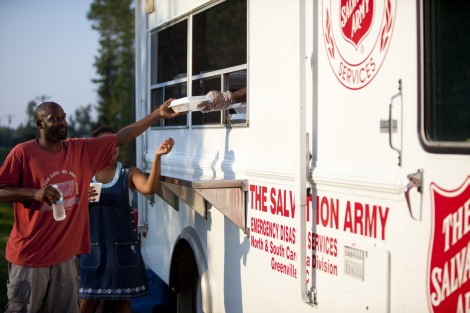Three Essential Steps In Building A Local Disaster Program
Jeff Jellets | jeff_jellets@uss.salvationarmy.org

In disaster services, we describe the Southern Territory as “the accident-prone portion of the country.” Whether its hurricanes, tornadoes, floods, ice storms, wildfires or even earthquakes – the 150 mile New Madrid Earthquake fault runs right through the middle of our territory – there is not an area of the South that is immune from disasters, both natural and man-made.
In fact, I was recently going over this litany of woe with a group of Salvation Army cadets when I was asked a very good question, “So … what do we do about it?” It is one thing to recognize your vulnerability to a disaster, but the real challenge is how best to prepare for it – especially when there is so much other work to be done on a daily basis.
What can we do to prepare locally for disasters? I think I can break it down into three recommendations:
- First, meet your local emergency manager. That is the person who is responsible for coordinating disaster response operations on behalf of your county or city government. In large metropolitan areas, the local emergency management agency may be an entire department, but in many smaller communities, emergency management may be a one person operation. If you are not on a first name basis with your local EM, invite him (or her) to lunch and start building a solid relationship. Ask about the hazards that threaten your community and county’s local disaster response plan. Be sure to explain how The Salvation Army can help and ask to be included in the county’s emergency activation procedures so that when a disaster happens, you are automatically alerted.
- Second, maintain your disaster equipment. If you have a canteen, drive it at least once a week and give it the same basic care you would any other vehicle, including regular oil changes to both the engine and generator. Neglect is the arch-enemy of our disaster fleet, and nothing is more embarrassing then being asked to respond by your friendly neighborhood emergency manager, but being unable to do so because the canteen won’t start. If you don’t have a canteen, build a small stockpile of disaster equipment. With just a few insulated food and beverage containers, you can transform any cargo van into an emergency food service delivery unit.
- Third, build a team. There’s that old adage that if you give a person a fish, they only eat for a day, but if you teach him to fish, they eat for a lifetime. Take the same approach with disaster volunteers. Invest time in recruiting and training a core disaster team. Develop them to a point where they are ready to respond in an emergency, even if you are not available, and can act as trustees for your disaster equipment, ensuring you canteen is driven regularly and properly maintained. While the initial investment of time and training may be steep, it is the long-term benefits that count. As your team becomes more experienced, basic disaster preparedness responsibilities can be shifted to them, allowing you more time to focus on leadership and other responsibilities.
One other point to remember: you don’t need to do this on your own. Reach out to your divisional disaster director for both guidance and assistance. If you don't know who your divisional disaster director is, go to the map on the bottom of the home page on this website and select your state.
If you want more online resources, poke around the menu bar of this website. There is a host of resources, from forms to podcasts, including a complete list of disaster training classes. Many of these training classes can be offered in your local corps or service center to jumpstart the formation of a disaster team.
Since I’m a sucker for good quotes, let me end with one from Hall of Fame football player Roger Staubach, who said, "In business or in football, it takes a lot of unspectacular preparation to produce spectacular results." The same could be said of disaster services and emergency management.
About The Salvation ArmyThe Salvation Army annually helps more than 30 million Americans overcome poverty, addiction, and economic hardships through a range of social services. By providing food for the hungry, emergency relief for disaster survivors, rehabilitation for those suffering from drug and alcohol abuse, and clothing and shelter for people in need, The Salvation Army is doing the most good at 7,600 centers of operation around the country. In the first-ever listing of “America’s Favorite Charities” by The Chronicle of Philanthropy, The Salvation Army ranked as the country’s largest privately funded, direct-service nonprofit. For more information, visit www.SalvationArmyUSA.org. Follow us on Twitter @SalvationArmyUS and #DoingTheMostGood.